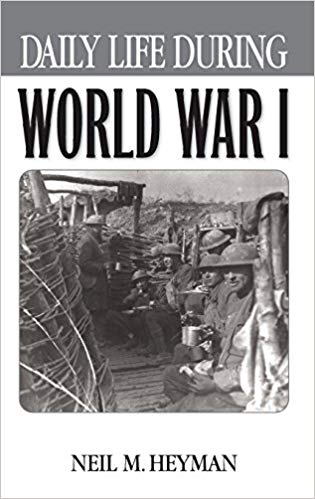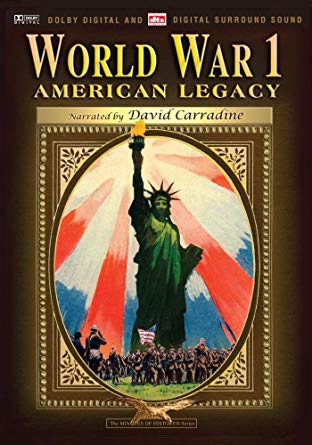
When I was small, my grandparents had a console TV with a framed photo sitting on top – right about eye level to a child. In the photo my grandfather, in uniform, sat astride a huge black horse. I was told he was in the Cavalry in World War I, but I had no idea what that meant.
This November 11 marks the 100th anniversary of the Armistice, the end of the Great War. You'll be seeing more WWI-themed entries in this blog and displays around the library. I wanted to learn more about a war we hardly see in movies or TV – especially compared to World War II with its clear villains and purpose. We – or I should say, I – know embarrassingly little about World War I.
I decided to research a bit, and found Daily Life During World War I by Neil M. Heyman from the fact-filled yet accessible Greenwood Press 'Daily Life Through History' Series. I also found a fast-moving, informative documentary called 'World War I: American Legacy' (which includes shots of Pittsburgh and the Boulevard of the Allies), available through Kanopy Streaming through our catalog. Of course, many other resources are online and on our shelves. In the meantime, here are some bits that fascinated me.

• What started the war had more to do with rising nationalism and German aggression than just the assassination of Archduke Ferdinand. As they say, 'it's complicated.'
• The war lasted from 1914 through 1918, but the U.S. didn't become involved until 1917 when German submarines sank the passenger ship Lusitania and attacked British and American merchant ships.
• Due to the large number of German immigrants in America, it was unclear to many Europeans which side the U.S. would join.
• After the U.S. entered the war, teaching German was often banned, German music wasn't played in concerts, and German terms like 'sauerkraut' were replaced by terms like 'liberty cabbage.'
• America, Great Britain, France, Belgium and other countries fighting Germany were and are called the 'belligerent nations.' (Imagine driving down the Boulevard of the Belligerents!)
• The horrors of trench warfare came not only from shelling but from digging and uncovering bodies and body parts from previous battles.
• Some battles were fought on mud so deep that wounded men drowned before they could be rescued.
• World War I gave us the terms 'in the trenches,' 'over the top' and 'shell shock.' What we call PTSD was recognized but not entirely accepted as a reason for hospitalization or an excuse from fighting.
• In addition to the Christmas cease fire of 1914, both sides often had unspoken agreements not to fire during soldiers' morning outhouse trips and during mealtimes.
• Food shortages led to food riots in some cities in Europe and in the U.S. Rather than rationing, President Wilson encouraged 'meat-free' and 'wheat-free' days.
• Machine guns, tanks, submarines and aircraft were all new in WWI. Planes were first used for reconnaissance, and pilots from opposing sides waved to each other; then shook their fists; then as they began to carry weapons, fired on each other. Airmen lived a more glamorous life than trench fighters, but faced even more risk from machine-gun and rifle fire, accidents, and friendly fire.
• Teddy Roosevelt lost a son, Quentin, during the war.
• Germans were among the first to return home after the war, and Americans as the occupying army were among the last.
As I learn more, I think of one historian's comment in the documentary, 'The world was different then.' Many young men, including my grandfather, volunteered from a sense of duty, a need for adventure beyond their small towns, or a desire to join their friends in service. A generation later, in a more open, confessional age, veterans of WWII were coaxed to tell stories by their children and grandchildren, but my parents certainly didn't ask my grandfather about his experiences, nor would he have told them. What I remember is that photo of him on horseback, staring at the camera, and it haunts me still.
by Jan Hardy, Cataloging Specialist
